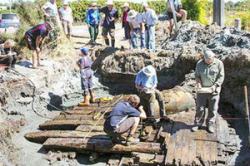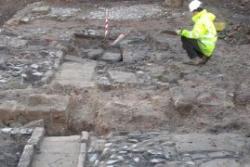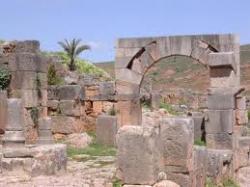INSTITUT SUPERIEUR D'ANTHROPOLOGIE
INSTITUTE OF ANTHROPOLOGY
ONLINE COURSES / COURS A DISTANCE
SUMMER TERM : JULY 2014
REGISTER NOW
NOUVELLE ZELANDE –  Cape Foulwind - The section of a ship excavated at Cape Foulwind just over a year ago may have come from the Mountain Maid, wrecked at the Buller River mouth in the 19th century. The wreck was first discovered more than 30 years ago and excavated again for research last March. A report recently released by Southern Pacific Archaeological Research concluded the fragment was likely to be from one of three ships wrecked at or near the Buller River mouth. It was most likely to have come from the Mountain Maid, a brig built in Aberdeen and wrecked at the mouth of the river, with most parts ending up on the Carters Beach shoreline in 1868. The other possibilities were the Yolande, wrecked in 1897, or the Oceola wrecked in 1887 while being towed out of Westport with a cargo of coal. The Mountain Maid was wrecked at a time when the beach was more or less adjacent to the main road, which is where the wreck fragment was found. The report said the fragment appeared to be a portside section of the bow quarter of the hull. It was possible, but less likely, it was a starboard side section from the stern quarter. It was from a ship likely to be 30 to 50 metres in length, with a six to eight-metre beam and about four metres in depth. The ship was likely to have been made using typical 19th century construction methods. At least some of the timbers used were of northern hemisphere species. The report said the storm-washed shipwreck fragment appeared to have been deposited close to the high tide mark. It was buried in sand to a depth of about 1.5 metres and long after deposition the whole fragment was seriously modified with a chainsaw to allow placement of a culvert.
Cape Foulwind - The section of a ship excavated at Cape Foulwind just over a year ago may have come from the Mountain Maid, wrecked at the Buller River mouth in the 19th century. The wreck was first discovered more than 30 years ago and excavated again for research last March. A report recently released by Southern Pacific Archaeological Research concluded the fragment was likely to be from one of three ships wrecked at or near the Buller River mouth. It was most likely to have come from the Mountain Maid, a brig built in Aberdeen and wrecked at the mouth of the river, with most parts ending up on the Carters Beach shoreline in 1868. The other possibilities were the Yolande, wrecked in 1897, or the Oceola wrecked in 1887 while being towed out of Westport with a cargo of coal. The Mountain Maid was wrecked at a time when the beach was more or less adjacent to the main road, which is where the wreck fragment was found. The report said the fragment appeared to be a portside section of the bow quarter of the hull. It was possible, but less likely, it was a starboard side section from the stern quarter. It was from a ship likely to be 30 to 50 metres in length, with a six to eight-metre beam and about four metres in depth. The ship was likely to have been made using typical 19th century construction methods. At least some of the timbers used were of northern hemisphere species. The report said the storm-washed shipwreck fragment appeared to have been deposited close to the high tide mark. It was buried in sand to a depth of about 1.5 metres and long after deposition the whole fragment was seriously modified with a chainsaw to allow placement of a culvert.
http://www.nzherald.co.nz/nz/news/article.cfm?c_id=1&objectid=11257769
INDE –  Puri - Expressing concern over the slow pace of conservation works in the Jagannath Temple at Puri, Odisha government has urged the Union Culture Ministry to ensure Archaeological Survey of India (ASI) expedites restoration and renovation works in the temple built in the 12th century.“The pace of progress and urgency to complete the conservation works by the ASI appears to be sluggish. You are aware that we have a fairly tight time schedule in view of the Nabakalebar Festival scheduled in July, 2015. The nagging problem of humidity and temperature inside the Garvagriha (Sanctum Sanctorum) also remains unresolved,” noted Chief Secretary J. K. Mohapatra in a letter to Union Culture Secretary Rabindra Singh.
Puri - Expressing concern over the slow pace of conservation works in the Jagannath Temple at Puri, Odisha government has urged the Union Culture Ministry to ensure Archaeological Survey of India (ASI) expedites restoration and renovation works in the temple built in the 12th century.“The pace of progress and urgency to complete the conservation works by the ASI appears to be sluggish. You are aware that we have a fairly tight time schedule in view of the Nabakalebar Festival scheduled in July, 2015. The nagging problem of humidity and temperature inside the Garvagriha (Sanctum Sanctorum) also remains unresolved,” noted Chief Secretary J. K. Mohapatra in a letter to Union Culture Secretary Rabindra Singh.
http://www.thehindu.com/news/national/other-states/expedite-conservation-work-in-jagannath-temple-asi-told/article6025072.ece?utm_source=RSS_Feed&utm_medium=RSS&utm_campaign=RSS_Syndication
ROYAUME UNI –  Woodland park - Items of pottery dating from medieval times have been discovered during an archaeological dig at a woodland park.For the past week volunteers and schools have helped Tees Archaeology dig down through the different layers of t he path, which it is believed may have connected the deserted medieval village at Newham with the old Gunnergate Lane. It runs between Fairy Dell park and the Dell.Archeologists found one piece of pottery from medieval times, and a Victorian clay pipe bowl, while a special trench dug for local schools to dig unearthed three pieces of medieval pottery. Rachel Grahame, from Tees Archaeology, said the dig had proved the sunken footpath was a thoroughfare dating from the Middle Ages which had not been surfaced, but used by people as a track over hundreds of years. It was used primarily by farm workers, as the entire area at that time was agricultural land.
Woodland park - Items of pottery dating from medieval times have been discovered during an archaeological dig at a woodland park.For the past week volunteers and schools have helped Tees Archaeology dig down through the different layers of t he path, which it is believed may have connected the deserted medieval village at Newham with the old Gunnergate Lane. It runs between Fairy Dell park and the Dell.Archeologists found one piece of pottery from medieval times, and a Victorian clay pipe bowl, while a special trench dug for local schools to dig unearthed three pieces of medieval pottery. Rachel Grahame, from Tees Archaeology, said the dig had proved the sunken footpath was a thoroughfare dating from the Middle Ages which had not been surfaced, but used by people as a track over hundreds of years. It was used primarily by farm workers, as the entire area at that time was agricultural land.
http://www.thenorthernecho.co.uk/news/11222157.Medieval_pottery_found_at_woodland_park/?ref=var_0
ROYAUME UNI –  Edinburgh - Archaeologists have now completed their survey, which unearthed new evidence about the development of Edinburgh’s World Heritage site. The excavations revealed that the tanning of animal hides was the main industrial process taking place on the site during the medieval period. CFA Archaeology has been working closely with Balfour Beatty and the City of Edinburgh Council archaeology service to recover medieval remains on the site. Finds include bronze pins and coins of different dates, pottery, clay pipes and animal bones, as well as environmental evidence that will help to picture what life in the Canongate was like over the last 800 years. Soil samples from the site will be analysed to give a better understanding of the plants and fruits that would have formed a part of the medieval diet. The archaeological dig was a planning requirement with the City of Edinburgh Council overseeing procedures. The area, just off Holyrood Road, occupies what were the medieval backlands (gardens and industrial areas to the rear of dwellings) of Canongate and is part of the city’s World Heritage site. Council archaeology officer John Lawson said:“We knew the site could help us understand how the Canongate developed from its origins in the 12th century to become the site of an important Victorian brewery but we were surprised to find over four metres of preserved architectural remains and rare survivals of materials. The site has revealed the first evidence of an industrial-scale tanning industry in Edinburgh and also provides vital information on the topography of Edinburgh. The survey has also helped to pinpoint the location of the boundary ditch that existed between Edinburgh and the Canongate for over 200 years.”
Edinburgh - Archaeologists have now completed their survey, which unearthed new evidence about the development of Edinburgh’s World Heritage site. The excavations revealed that the tanning of animal hides was the main industrial process taking place on the site during the medieval period. CFA Archaeology has been working closely with Balfour Beatty and the City of Edinburgh Council archaeology service to recover medieval remains on the site. Finds include bronze pins and coins of different dates, pottery, clay pipes and animal bones, as well as environmental evidence that will help to picture what life in the Canongate was like over the last 800 years. Soil samples from the site will be analysed to give a better understanding of the plants and fruits that would have formed a part of the medieval diet. The archaeological dig was a planning requirement with the City of Edinburgh Council overseeing procedures. The area, just off Holyrood Road, occupies what were the medieval backlands (gardens and industrial areas to the rear of dwellings) of Canongate and is part of the city’s World Heritage site. Council archaeology officer John Lawson said:“We knew the site could help us understand how the Canongate developed from its origins in the 12th century to become the site of an important Victorian brewery but we were surprised to find over four metres of preserved architectural remains and rare survivals of materials. The site has revealed the first evidence of an industrial-scale tanning industry in Edinburgh and also provides vital information on the topography of Edinburgh. The survey has also helped to pinpoint the location of the boundary ditch that existed between Edinburgh and the Canongate for over 200 years.”
http://www.theconstructionindex.co.uk/news/view/balfour-beatty-dig-sheds-light-on-edinburghs-past
ROYAUME UNI –  Iles Vierges -Archaeologists working on two small Caribbean islands have found artifacts intentionally buried beneath two 18th-century plantation houses. They appear to have been placed there for their spiritual power, protecting the inhabitants against harm, said John Chenoweth, a professor at the University of Michigan-Dearborn, in an interview with Live Science. The discoveries were made recently in the British Virgin Islands, an overseas territory of the United Kingdom.
Iles Vierges -Archaeologists working on two small Caribbean islands have found artifacts intentionally buried beneath two 18th-century plantation houses. They appear to have been placed there for their spiritual power, protecting the inhabitants against harm, said John Chenoweth, a professor at the University of Michigan-Dearborn, in an interview with Live Science. The discoveries were made recently in the British Virgin Islands, an overseas territory of the United Kingdom.
http://www.livescience.com/45696-artifacts-unearthed-in-caribbean.html
ALGERIE-  Tiddis - Suivant un ordre chronologique partant du pied au sommet de la montagne, la cité antique de Tiddis (nord-ouest de Constantine) déroule plus de 3000 ans de l'histoire d'Algérie à ses périodes lybique, punique, romaine et byzantine. De l'époque punique où elle devait s'appelait Taddart ou Ras Eddar, n'est aujourd'hui visible qu'une bazina circulaire, un monument mortuaire collectif, des dolmens, et du mobilier funéraire, témoins de la présence de vieilles civilisations berbères. Un arc typiquement romain marque l'entrée du Castellum Tidditanorum, l'autre nom de Tiddis, et le début du cardo (réseau de rues) dont les dallages restent bien conservés et qui longe deux temples dédiés à des divinités romaines. Plus haut, se dressent le plus petit forum construit par les Romains. S'y trouvent les statuts et dédicaces à Septime Sévère (empereur romain d'origine nord-africaine) et sa famille ainsi que deux arcs perpendiculaires symbolisant le croisement typique entre les deux voies divisant les villes romaines. En poursuivant l'ascension, des maisons de potiers conservent encore les bacs d'argile qui ont fait la renommée de la cité ainsi que des réservoirs d'eau.
Tiddis - Suivant un ordre chronologique partant du pied au sommet de la montagne, la cité antique de Tiddis (nord-ouest de Constantine) déroule plus de 3000 ans de l'histoire d'Algérie à ses périodes lybique, punique, romaine et byzantine. De l'époque punique où elle devait s'appelait Taddart ou Ras Eddar, n'est aujourd'hui visible qu'une bazina circulaire, un monument mortuaire collectif, des dolmens, et du mobilier funéraire, témoins de la présence de vieilles civilisations berbères. Un arc typiquement romain marque l'entrée du Castellum Tidditanorum, l'autre nom de Tiddis, et le début du cardo (réseau de rues) dont les dallages restent bien conservés et qui longe deux temples dédiés à des divinités romaines. Plus haut, se dressent le plus petit forum construit par les Romains. S'y trouvent les statuts et dédicaces à Septime Sévère (empereur romain d'origine nord-africaine) et sa famille ainsi que deux arcs perpendiculaires symbolisant le croisement typique entre les deux voies divisant les villes romaines. En poursuivant l'ascension, des maisons de potiers conservent encore les bacs d'argile qui ont fait la renommée de la cité ainsi que des réservoirs d'eau.
Les vestiges des thermes, de la villa à mosaïque, ainsi qu'une huilerie et un moulin à céréales, sont autant de témoins de l'activité économique de la cité à laquelle une tour de surveillance et un rempart byzantins viendront s'ajouter plus tard. Egalement appelée «La cité des divinités», Tiddis renseigne sur l'évolution des croyances dans la cité à travers des rites funéraires libyques puis des temples à la gloire de divinités antiques, comme les déesses romaines Vesta, Mirtha et Ceres, ainsi qu'un sanctuaire au sommet dédié au culte de Baâl Hammon, une divinité carthaginoise. Plus tard, un premier temple chrétien sera érigé en face du sanctuaire de Mirtha et, au-dessus, un baptistère. La cité antique de Tiddis conserve également des traces sur les conditions de travail de l'archéologue français, André Berthier, à l'origine de sa découverte. Sa cabane et ses outils de travail s'y trouvent encore et renseignent sur la vie du chercheur qui a consacré plus de 30 ans de sa carrière au seul site de Tiddis. Une trentaine d'hectares attendent encore d'être sondés et fouillés pour compléter les travaux d'André Berthier, explorer complètement le site et mettre au jour toutes la richesse archéologique qu'il recèle.
http://www.lexpressiondz.com/culture/194878-un-site-archeologique-des-plus-riches-d-algerie.html